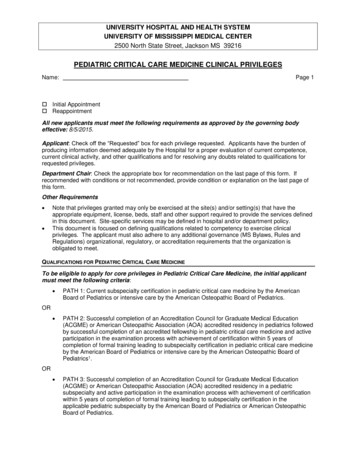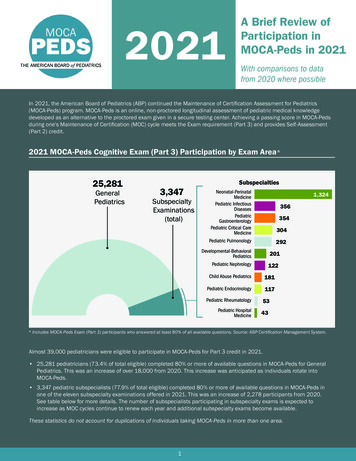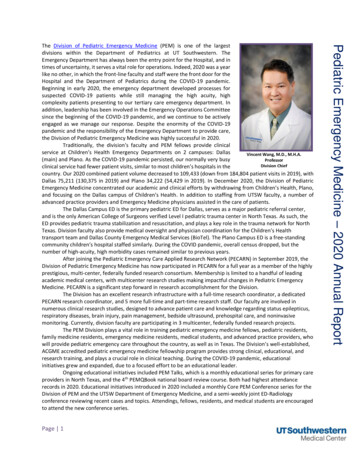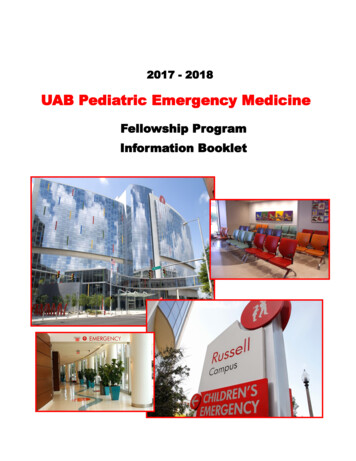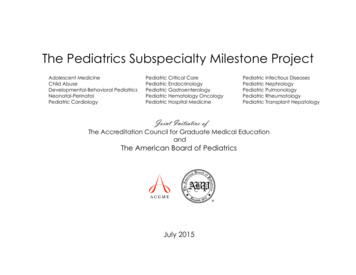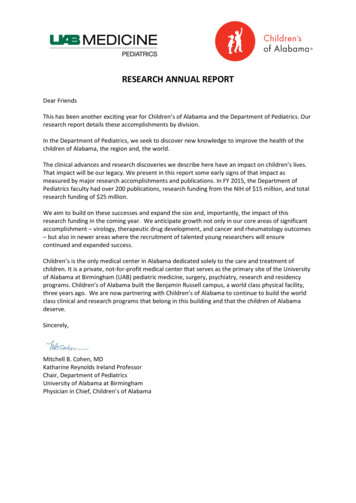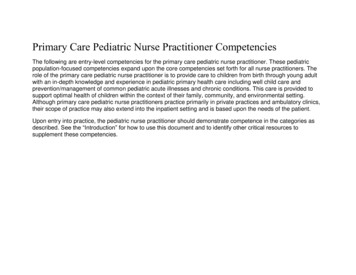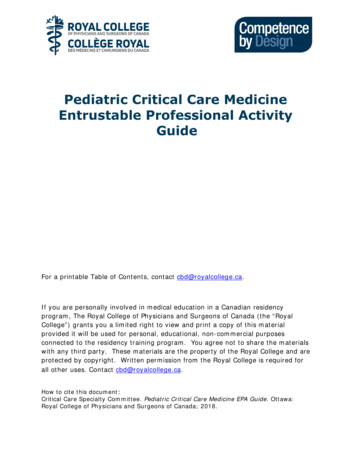
Transcription
Pediatric Critical Care MedicineEntrustable Professional ActivityGuideFor a printable Table of Contents, contact cbd@royalcollege.ca.If you are personally involved in medical education in a Canadian residencyprogram, The Royal College of Physicians and Surgeons of Canada (the “RoyalCollege”) grants you a limited right to view and print a copy of this materialprovided it will be used for personal, educational, non-commercial purposesconnected to the residency training program. You agree not to share the materialswith any third party. These materials are the property of the Royal College and areprotected by copyright. Written permission from the Royal College is required forall other uses. Contact cbd@royalcollege.ca.How to cite this document:Critical Care Specialty Committee. Pediatric Critical Care Medicine EPA Guide. Ottawa:Royal College of Physicians and Surgeons of Canada; 2018.
Origins and UseThis document, commonly known as the Pediatric Critical Care Medicine EPA Guide, wasdeveloped by the Royal College’s Critical Care Specialty Committee to support thediscipline’s transition to Competence by Design (CBD). The format and structure of thedocument is designed specifically to support the development of the Royal College’stechnical infrastructure. Recognizing, however, that some faculty and residents will benefitfrom access to the document for teaching and planning purposes, the Royal College hasopted to make the technical document available, as is. This material is subject to change.It is the user’s responsibility to ensure that he/she is using the latest version, which isaccessible via the Royal College’s website.Structure and FormatThe following information provides guidance on navigation and interpretation of the variouselements of this technical document.When working with the electronic version of this document, you will find a navigation bar onthe left-hand side of the PDF. This will support quick and easy transition between items.Many of the items span multiple pages and share common design features. The followingtable describes the different design elements and should help users navigate through theitems.FeatureDescriptionTitleThe title of each item includes the name of the discipline followed by thestage of training and item number. Items in each stage of training beginat number one.In some cases, there may be a letter after the number (i.e. an A or P).The letter refers to the stream within the discipline to which this item isapplicable (e.g. 1AP – Item 1 is applicable to both the adult and pediatricstream).EPA nameThe Entrustable Professional Activity (EPA) name appears immediatelyafter the title. This is a statement about the work of the discipline. It isobservable and measurable.Key featuresThe key features section describes the EPA and may include: the focus of the EPA (e.g. body system, type of injury, safepatient monitoring), different aspects of the observation (E.g. patient assessment andprocedural skills, observed in preoperative clinic) pre-learning requirements (E.g. builds on skills previouslyattained), or procedural requirements (E.g., includes surgical and non-surgicalmanagement)This description helps both residents and supervisors better understandthe nature and limitations of this professional activity; it may alsoemphasize requirements for consideration of entrustability. 2018 The Royal College of Physicians and Surgeons of Canada.Page 2 of 52
AssessmentPlanThe assessment plan describes the nature of the information that shouldbe provided to the Competence Committee in order for that group tohave enough information that they are able to make a decision regardingentrustment of this professional activity. This includes instruction on whois to provide the observation information (supervisor, delegate, otherhealth professionals), the nature of the observation (e.g., direct orindirect), as well as the suggested ePortfolio observation form(s).This section also lists any additional information that should be collectedabout the case or observation, such as patient factors, diagnoses,treatments, and/or setting of care. This information helps build theobservation form. The various factors included in this section are selectedby the specialty committee in order to provide the CompetenceCommittee with the breadth of information required to make a decisionregarding entrustment of this EPA.RelevantCanMEDSMilestonesMost EPAs are comprised of several CanMEDS milestones. Eachmilestone is preceded by a series of letters and numbers which link themilestone to the corresponding key and enabling competency withinCanMEDS Interactive.For example, if the code is ME 1.6.-ME refers to the CanMEDS Role, Medical Expert. Other possibilities areCOM Communicator, COL Collaborator, L Leader, HA HealthAdvocate, S Scholar and P Professional.-1.6 refers to the Key and enabling competencies within theaforementioned Role.Contact us if you have any questions or comments about this document atcbd@royalcollege.ca 2018 The Royal College of Physicians and Surgeons of Canada.Page 3 of 52
Entrustable Professional Activities forPediatric Critical Care Medicine2019VERSION 1.0Critical Care Medicine: Transition to Discipline EPA #1PRecognizing, assessing, and providing initial management for patients who arecritically ill, seeking assistance when appropriateKey Features:- This EPA focuses on the initial medical care of patients who are critically ill, includingassessment, initial diagnosis, and preliminary management. An important feature ofthis EPA is the timely and appropriate recognition of the need for additionalassistance.- It may include the recognition of clinical deterioration of a patient already in theintensive care unit.- This EPA may be observed in a variety of clinical settings, including the intensivecare unit, emergency room, and on the wards.- This EPA does not include resuscitation (TTD2), nor developing a fully matureddifferential diagnosis for complex presentations, or a complete management plan(F1).Assessment plan:Direct observation and/or case review by attending physician or senior traineeUse Form 1. Form collects information on:- Observation: direct; indirectCollect 2 observations of achievement.- At least 1 direct observation- At least 2 different observersRelevant Milestones:1ME 1.4 Perform focused clinical assessments that address all relevant issues2ME 2.1 Prioritize issues to address in the patient’s assessment andmanagement3ME 1.4 Recognize urgent problems and one’s own limitations, and seekassistance as needed4ME 1.6 Identify clinical situations in which complexity, uncertainty, and ambiguitymay play a role in decision-making 2018 The Royal College of Physicians and Surgeons of Canada. All rights reserved.This document may be reproduced for educational purposes only provided that the following phrase is included in all related materials: Copyright 2018 The Royal College ofPhysicians and Surgeons of Canada. Referenced and produced with permission. Please forward a copy of the final product to the Office of Specialty Education, attn: Associate Director,Specialties. Written permission from the Royal College is required for all other uses. For further information regarding intellectual property, please contact: documents@royalcollege.ca.For questions regarding the use of this document, please contact: credentials@royalcollege.edu.Page 4 of 52
ENTRUSTABLE PROFESSIONAL ACTIVITIES FORPEDIATRIC CRITICAL CARE MEDICINE (2019)5ME 2.3 Ascertain the patient’s goals of care and ensure care is aligned with thosegoals, as the patient’s situation evolves6ME 2.2 Develop an initial diagnosis relevant to the patient’s presentation7COM 3.1 Communicate in a clear, compassionate, respectful, and accurate mannerto the patient and family8COM 5.1 Document relevant information9COL 1.2 Seek and respond to input from other health care professionals10COL 1.3 Communicate clearly and directly to promote understanding in the healthcare team11L 2.1 Consider health care resources and costs when determining the investigationand management plan12HA 1.1 Facilitate timely access to limited health care resources 2018 The Royal College of Physicians and Surgeons of Canada. All rights reserved.Page 5 of 52
ENTRUSTABLE PROFESSIONAL ACTIVITIES FORPEDIATRIC CRITICAL CARE MEDICINE (2019)Critical Care Medicine: Transition to Discipline EPA #2PInitiating resuscitation for unstable patientsKey Features:- This EPA focuses on initiating resuscitation for critically ill patients, following theprinciples of crisis resource management.Assessment plan:Direct observation by ED physician, senior trainee, or other health care professionals (i.e.code/MET nurse)Use Form 1. Form collects information on:- Condition: cardiac arrest; respiratory failure; sepsis; shock; other (write in)- Context: clinical; simulationCollect 2 observations of achievement.- At least 2 different observersRelevant Milestones:1ME 2.2 Provide assessment and initial stabilization of ABCs (Airway,Breathing, and Circulation)2ME 1.4 Recognize urgent problems and one’s own limitations and seek theassistance3L 4.2 Lead the resuscitation team effectively, ensuring clear roles andresponsibilities for team members, setting priorities, providing constructiveintervention when required, and re-evaluating patient and situationfrequently4COL 1.3 Communicate with the health care team using clear language,knowledge sharing and summarizing clinical evolution5COL 2.2 Communicate orders clearly citing names (or other identification)and using closed loop communication 2018 The Royal College of Physicians and Surgeons of Canada. All rights reserved.Page 6 of 52
ENTRUSTABLE PROFESSIONAL ACTIVITIES FORPEDIATRIC CRITICAL CARE MEDICINE (2019)Critical Care Medicine: Transition to Discipline EPA #3PPerforming the basic procedures of CCMKey Features:- This EPA includes determining which procedures are necessary and appropriate tothe situation.- Procedures include bag-valve-mask (BVM) ventilation with oropharyngeal airway(OPA)/nasopharyngeal airway (NPA) insertion, chest compressions and defibrillation,intra-osseous placement and lumbar puncture.- This EPA does not include other commonly performed procedures that are present inthe other stages of training (Foundations 3 and Core 4)Assessment plan:Direct observation by supervisorUse Form 2. Form collects information on:- Procedure: bag-mask ventilation with oropharyngeal airway; intra-osseousplacement; chest compressions; defibrillation; lumbar puncture- Setting: clinical; simulationCollect 6 observations of achievement.- At least 2 episodes of bag-mask ventilation with OPA insertion (may be observed insimulation)- At least 1 intra-osseous placement (may be observed in simulation)- At least 1 observation of chest compressions (may be observed in simulation)- At least 1 observation of defibrillation (may be observed in simulation)- At least 1 observation of a lumbar puncture (may be observed in simulation)- At least 2 observersRelevant Milestones:1ME 3.1 Preprocedure plan: Gather/assess required information to reachdiagnosis and determine correct procedure required2ME 3.4 Case preparation: Patient correctly prepared and positioned,understands approach and required instruments, prepared to deal withprobable complications3ME 1.3 Knowledge of specific procedural steps: Understands steps ofprocedure, potential risks, and means to avoid/overcome them4ME 3.4.Technical performance: Efficiently performs steps, avoiding pitfallsand respecting soft tissues5ME 3.4 Visuospatial skills: 3D spatial orientation and able to positioninstruments/hardware where intended 2018 The Royal College of Physicians and Surgeons of Canada. All rights reserved.Page 7 of 52
ENTRUSTABLE PROFESSIONAL ACTIVITIES FORPEDIATRIC CRITICAL CARE MEDICINE (2019)6ME 3.4 Efficiency and flow: Obvious planned course of procedure witheconomy of movement and flow7ME 3.4 Postprocedure plan: Appropriate complete post procedure plan8COL 1.3 Professional and effective communication/utilization of staff 2018 The Royal College of Physicians and Surgeons of Canada. All rights reserved.Page 8 of 52
ENTRUSTABLE PROFESSIONAL ACTIVITIES FORPEDIATRIC CRITICAL CARE MEDICINE (2019)Critical Care Medicine: Transition to Discipline EPA #4PCoordinating patient care and supporting team members in the ICU settingKey Features:- This EPA focuses on organizational skills and role modeling.- It includes coordinating patient care, demonstrating leadership, and supportingjunior learners.- This EPA is not based on the resident leading the entire team through rounds ormanaging all patients.Assessment plan:Direct observation by supervisor. Each observation should include multiple days of service.Use Form 1.Collect 2 observations of achievement- At least 2 different observersRelevant Milestones:1S 2.3 Assign and prioritize tasks for junior residents2S 2.3 Supervise learners to ensure they work within their limitations, ensuringpatient safety3COL 1.2 Identify the roles and scopes of practice of health care providersrelated to Critical Care Medicine and utilize their expertise appropriately4COL 2.1 Actively listen to and engage in interactions with collaborators5P 2.1 Role-model behaviours that demonstrate accountability to patients,society and the profession6P 1.1 Complete assigned responsibilities, including following up with juniorresidents on tasks that they were assigned7ME 5.2 Use cognitive aids such as clinical care paths to enhance patient safety 2018 The Royal College of Physicians and Surgeons of Canada. All rights reserved.Page 9 of 52
ENTRUSTABLE PROFESSIONAL ACTIVITIES FORPEDIATRIC CRITICAL CARE MEDICINE (2019)Critical Care Medicine: Transition to Discipline EPA #5PTransferring clinical information between health care providers at handoverKey Features:- This EPA focuses on the communication required for safe handover within the criticalcare patient team or as the patient leaves the unit to another health care setting.- It includes the timely written documentation of the events while in the ICU (includingappropriate record-keeping, daily events), as well as verbal handover when going offduty and at the end of call shifts.Assessment plan:Direct observation and/or review of documentation (chart, handover paperwork,transfer/discharge note) by supervisor and/or physician receiving handoverUse Form 1. Form collects information on:- Observation (select all that apply): direct handover observation; chart review;handover paperwork; transfer/discharge noteCollect 3 observations of achievement.- At least 2 direct observations- At least 1 transfer/discharge note- At least 1 observation by supervisor or senior trainee in CCM- At least 1 observation by physician from another team receiving handoverRelevant Milestones:1ME 1.5 Prioritize among patients based on clinical acuity2ME 4.1 Establish plans for ongoing care, including follow-up oninvestigations and response to treatment3COL 3.2 Describe specific information required for safe and effective handoverduring transitions in care4COM 5.1 Organize information systematically within an electronic or written medicalrecord5COM 5.1 Maintain accurate and up-to-date problem lists6COM 5.1 Document information about patients and their medical conditions in amanner that enhances intra- and interprofessional care7COL 3.1 Identify patients requiring handover to other physicians or health careprofessionals8COL 3.2 Summarize patient issues, including plans to deal with ongoingconcerns9COL 3.2 Provide anticipatory guidance for issues that are likely to arise10COL 1.3 Communicate clearly and directly to promote understanding in the healthcare team 2018 The Royal College of Physicians and Surgeons of Canada. All rights reserved.Page 10 of 52
ENTRUSTABLE PROFESSIONAL ACTIVITIES FORPEDIATRIC CRITICAL CARE MEDICINE (2019)Critical Care Medicine: Transition to Discipline EPA #6PProviding routine updates to patients or familiesKey Features:- This EPA focuses on the application of medical expertise and communication skills tosummarize medical conditions and plans for the day to patients and families in theICU setting.- It does not include managing challenging conversations, such as end-of-lifediscussion or disclosure of adverse events.Assessment plan:Direct observation by supervisorUse Form 1. Form collects information on:- Condition: (write in)Collect 2 observations of achievement.- At least 2 observersRelevant Milestones:1P 1.2 Ensure that the patient and family are informed about the diagnosis and planof care2COM 1.1 Introduce oneself and explain one’s role in the interprofessionalteam3COM 1.1 Communicate using a patient-centered approach that facilitatespatient trust and autonomy and that is characterized by empathy, respect,and compassion4COM 3.1 Convey information about medical course and management planclearly and accuratelyCOM 3.1 Use appropriate language and avoid medical jargon56COM 1.4 Identify, verify and validate non-verbal cues on the part of the patient and/or family.7COM 3.1 Use strategies to verify and validate the understanding of thepatient and family.8COM 5.1 Document the clinical encounter to accurately reflect the discussion anddecisions9P 1.1 Respect diversity and difference, including but not limited to the impact ofsocio-economic background, gender, religion and cultural beliefs on decision making 2018 The Royal College of Physicians and Surgeons of Canada. All rights reserved.Page 11 of 52
ENTRUSTABLE PROFESSIONAL ACTIVITIES FORPEDIATRIC CRITICAL CARE MEDICINE (2019)Critical Care Medicine: Foundations EPA #1PEvaluating, stabilizing, and managing patients presenting with common ICUconditionsKey Features:- This EPA focuses on routine ICU care, including evaluating, stabilizing, admitting,and providing day-to-day management for patients with uncomplicated criticalillness.- This includes: diagnosis and management of the presenting problem, managementof any underlying conditions, prevention and management of common ICUcomplications, and attention to and management of nutrition, sedation, andanalgesia.- This EPA does not include patients with complex, poorly differentiated or multi-typeshock/organ dysfunction, polypharmacy overdose, multi-system or multicomorbidillness, multi-system trauma, and transplant, nor the critically ill obstetrical patient.Assessment Plan:Direct observation and/or review of admission/case discussion by attending physician orsenior resident with feedback from bedside RN, charge RN, RRT, and/or junior traineesUse Form 1. Form collects information on:- Setting: initial assessment; daily care- Presentation: surgical; medical- Primary diagnosis: (write in)Collect 6 observations of achievement.- At least 3 initial assessment- At least 3 daily care- Variety of medical and surgical presentationsRelevant Milestones:1ME 1.3 Apply knowledge of basic physiology to the management of common ICUconditions2ME 1.4 Perform focused clinical assessments that address all relevant issues3ME 1.6 Develop a plan that considers the current complexity, uncertainty andambiguity in a clinical situation4ME 2.2 Select and interpret the results of investigations and imaging5ME 2.3 Work with the patient and family to establish goals of care 2018 The Royal College of Physicians and Surgeons of Canada. All rights reserved.Page 12 of 52
ENTRUSTABLE PROFESSIONAL ACTIVITIES FORPEDIATRIC CRITICAL CARE MEDICINE (2019)6ME 2.4 Develop and implement initial and/or ongoing management plans forpatients with common ICU conditions7ME 2.4 Develop plans to monitor the evolution of the clinical course and/or thepatient’s response to treatment8ME 3.1 Integrate planned procedures or therapies into the overall plan of care9ME 4.1 Determine the need and timing of consultation with other specialists10ME 5.2 Organize safe intrahospital transport of patient to and from ICU, using allnecessary human and equipment resources, recognizing when it may beinappropriate to transport patient11COL 1.2 Implement a multidisciplinary approach to the care of ICU patients12COL 1.3 Engage in respectful shared decision-making with physicians andcolleagues in other health care professions13P 2.2 Demonstrate a commitment to patient safety and quality improvementthrough adherence to institutional policies and procedures 2018 The Royal College of Physicians and Surgeons of Canada. All rights reserved.Page 13 of 52
ENTRUSTABLE PROFESSIONAL ACTIVITIES FORPEDIATRIC CRITICAL CARE MEDICINE (2019)Critical Care Medicine: Foundations EPA #2PEvaluating and managing uncomplicated and/or routine patients requiringmechanical ventilationKey Features:- This EPA focuses on applying knowledge of invasive and non-invasive (NIV)mechanical ventilation, its indications and complications.- It includes the initiation, maintenance, weaning, and discontinuation of mechanicalventilation in the context of common clinical scenarios with respiratory failure due topulmonary and non-pulmonary reasons.- This EPA may be observed during clinical assessment, patient rounds, or whileteaching other trainees.- This EPA does not include patients with complicated, severe, refractory disease (e.g.,severe hypoxic or hypercapnic respiratory failure, severe airway obstruction,patient/ventilator asynchrony, complicated waveform analysis, etc.).Assessment Plan:Direct and indirect observation by attending physician or senior trainee with input fromregistered respiratory therapist(s) (RRT)Use Form 1. Form collects information on:- Ventilation technique: invasive; non-invasive- Case mix (select all that apply): initiation; maintenance; weaning; discontinuation- Reason for resp support: pulmonary; non-pulmonaryCollect 9 observations of achievement.- At least 1 non-invasive ventilation for each case mix- At least 1 invasive ventilation for each case mix for a patient with pulmonary reasonsfor respiratory support- At least 6 observations by attending physiciansRelevant Milestones:1ME 1.3 Apply knowledge of respiratory physiology and cardiopulmonaryinteractions2ME 1.6 Develop a plan that considers the current complexity, uncertainty, andambiguity in a clinical situation3ME 2.2 Interpret diagnostic imaging of the respiratory system4ME 2.4 Develop and implement an initial management plan foruncomplicated patients requiring non-invasive or invasive ventilation 2018 The Royal College of Physicians and Surgeons of Canada. All rights reserved.Page 14 of 52
ENTRUSTABLE PROFESSIONAL ACTIVITIES FORPEDIATRIC CRITICAL CARE MEDICINE (2019)5ME 3.2 Ensure that the patient and family are informed about the risks and benefitsof each treatment options in the context of best evidence and guidelines6ME 5.2 Use cognitive aids such as clinical care paths to enhance patient safety7COM 3.1 Use strategies to verify and validate the understanding of the patient andfamily8COM 4.3 Answer questions from the patient and family about next steps9COL 1.2 Seek and respond to input from other health care professionals 2018 The Royal College of Physicians and Surgeons of Canada. All rights reserved.Page 15 of 52
ENTRUSTABLE PROFESSIONAL ACTIVITIES FORPEDIATRIC CRITICAL CARE MEDICINE (2019)Critical Care Medicine: Foundations EPA #3PPerforming the common procedures of CCMKey Features:- This EPA focuses on determining which procedures are necessary and clinicallyappropriate, and performing common procedures as outlined below.- Procedures include airway management skill in uncomplicated patients; arterial lineinsertion in complicated patients; cardioversion; central venous line insertion; chesttube insertion; This EPA includes using ultrasonography for procedural guidancewhere appropriate.- This EPA may be observed in various clinical settings and simulation.Assessment Plan:Direct observation by attending or consultant physician, or TTP level trainee with input frombedside RN, RRT, NP or PAUse form 2. Form collects information on:- Procedure[select all that apply]: airway management; intubation; arterial line;cardioversion; central venous line; open chest tube; Seldinger technique chest drain- Complexity: complicated/urgent; uncomplicated- Ultrasound guidance: yes; no- Setting: clinical; simulation- Site: not applicable; brachial; femoral; jugular; radial; subclavian; other (write in)Collect 17 observations of achievement.- At least 5 airway management in clinical setting including intubation- At least 2 physician assessors for airway management- At least 5 arterial line insertions in clinical setting- At least 1 arterial line insertion each at femoral and radial site- At least 5 central line insertions- At least 1 central line insertion each at jugular, femoral and subclavian site- At least 1 open chest tube (may be observed in simulation)- At least 1 Seldinger chest tubeRelevant Milestones:1ME 3.1 Preprocedure plan: Gather/assess required information to reachdiagnosis and determine correct procedure required2ME 3.4 Case preparation: Patient correctly prepared and positioned,understands approach and required instruments, prepared to deal withprobable complications 2018 The Royal College of Physicians and Surgeons of Canada. All rights reserved.Page 16 of 52
ENTRUSTABLE PROFESSIONAL ACTIVITIES FORPEDIATRIC CRITICAL CARE MEDICINE (2019)3ME 1.3 Knowledge of specific procedural steps: Understands steps ofprocedure, potential risks, and means to avoid/overcome them4ME 3.4.Technical performance: Efficiently performs steps, avoiding pitfallsand respecting soft tissues5ME 3.4 Visuospatial skills: 3D spatial orientation and able to positioninstruments/hardware where intended6ME 3.4 Efficiency and flow: Obvious planned course of procedure witheconomy of movement and flow7ME 3.4 Postprocedure plan: Appropriate complete post procedure plan8COL 1.3 Professional and effective communication/utilization of staff 2018 The Royal College of Physicians and Surgeons of Canada. All rights reserved.Page 17 of 52
ENTRUSTABLE PROFESSIONAL ACTIVITIES FORPEDIATRIC CRITICAL CARE MEDICINE (2019)Critical Care Medicine: Foundations EPA #4PTeaching and supervising junior physicians and other health care professionalsKey Features:- This EPA focuses on informal/bedside teaching (i.e. teaching a procedure, reviewinga case in person or by phone) and helping junior learners identify their own gaps inknowledge and skill, and to develop a plan for their acquisition.- This EPA may be completed in a simulation setting.Assessment Plan:Direct observation by attending physician, senior resident in Critical Care Medicine, or otherfaculty/consultants with input from junior trainees and/or other health care professionalsUse Form 1. Form collects information on;- Teaching activity: teaching a procedure; telephone support; other (write in)- Setting: clinical; simulationCollect 4 observation of achievement.- At least 1 teaching a procedure- At least 1 telephone supportRelevant Milestones:1S 2.1 Use strategies for deliberate, positive role-modelling2S 2.2 Create a positive learning environment3S 2.4 Identify the learning needs and desired learning outcomes of others4COL 1.2 Assign tasks and responsibilities to other team members,commensurate with their skills and patient complexity5COL 2.1 Delegate tasks and responsibilities in a respectful manner6S 2.3 Provide learners with opportunities for appropriate clinicalresponsibility7S 2.3 Supervise learners to ensure they work within their limitations,ensuring patient safety8S 2.5 Provide feedback to enhance learning and performance9P 1.1 Intervene when behaviours toward colleagues and/or learners undermine arespectful environment10S 2.3 Identify unsafe clinical situations involving learners and manage themappropriately 2018 The Royal College of Physicians and Surgeons of Canada. All rights reserved.Page 18 of 52
ENTRUSTABLE PROFESSIONAL ACTIVITIES FORPEDIATRIC CRITICAL CARE MEDICINE (2019)Critical Care Medicine: Foundations EPA #5PDeveloping and implementing learning plansKey Features:- This EPA includes reflecting on performance feedback, knowledge & skill gaps andplanning for growth in current practice as well as future practice, including careerpath.- This includes selecting appropriate electives and clinical experiences, conferencesand other educational opportunities based on identified knowledge or skill gaps andfuture career path.- The observation of this EPA may be achieved via interactions with a supervisor/mentor or via guided self-reflection.- The self-reflection requires submission of written documentation that includesidentified learning needs and how the residents has facilitated growth in theirdomain.Assessment Plan:Interaction with supervisor/mentor: Direct and/or indirect observation by academic advisor,mentor, academic supervisor, and/or program director based on ongoing interaction, andsupplemented by any written documentation the resident submits (e.g., reflective journal,documentation of learning activities)OrGuided self-reflection: Submission to Competence Committee of written documentationand/or reflective journal.Use Form 4.Collect 1 observation of achievement.Relevant Milestones:1S 1.1 Create and implement a learning plan2S 1.1 Identify learning needs to enhance competence across all CanMEDS roles andgenerate immediate and longer-term career goals3S 1.2 Identify opportunities for learning and improvement by reflecting on andassessing performance using various internal and external data sources4S 3.1 Generate focused questions that address practice uncertainty and knowledgegaps5S 3.4 Integrate best evidence and clinical expertise into decision-making 2018 The Royal College of Physicians and Surgeons of Canada. All rights reserved.Page 19 of 52
ENTRUSTABLE PROFESSIONAL ACTIVITIES FORPEDIATRIC CRITICAL CARE MEDICINE (2019)6L 4.2 Adjust educational experiences to gain competencies necessary for futureindependent practice7P 1.2 Demonstrate a commitment to excellence in all aspects of practice8P 2.1 Demonstrate a
9 COL 1.2 Seek and respond to input from other health care professionals 10 COL 1.3. Communicate clearly and directly to promote understanding in the health care team . 11 L 2.1. Consider health care resources and costs when determining the investigation and management plan . 12 HA 1.1. Facilitate timely access to limited health care resources
